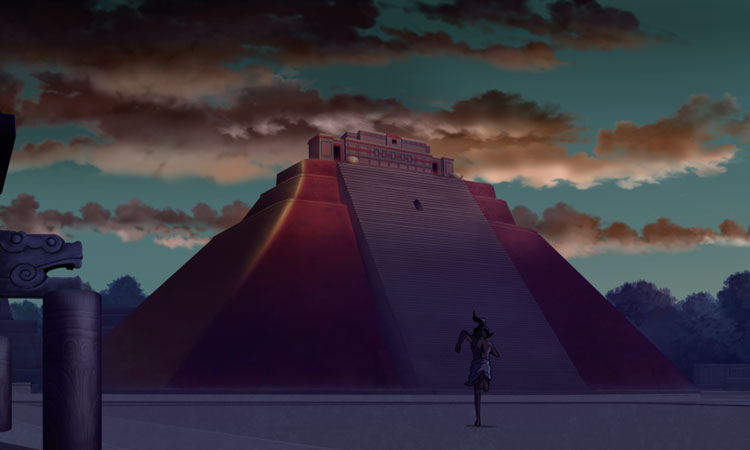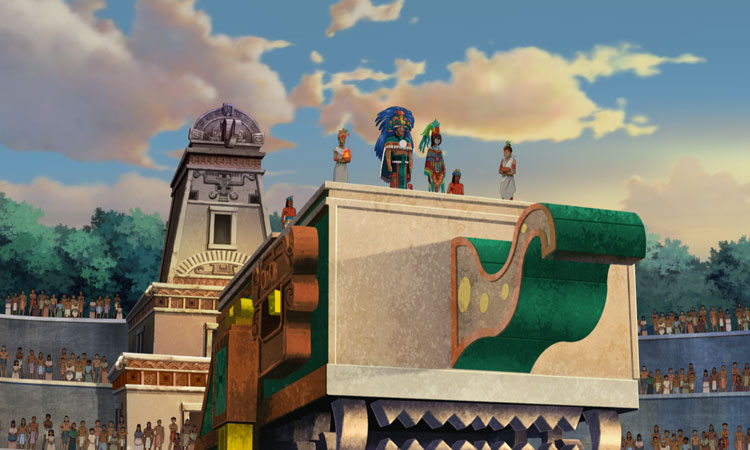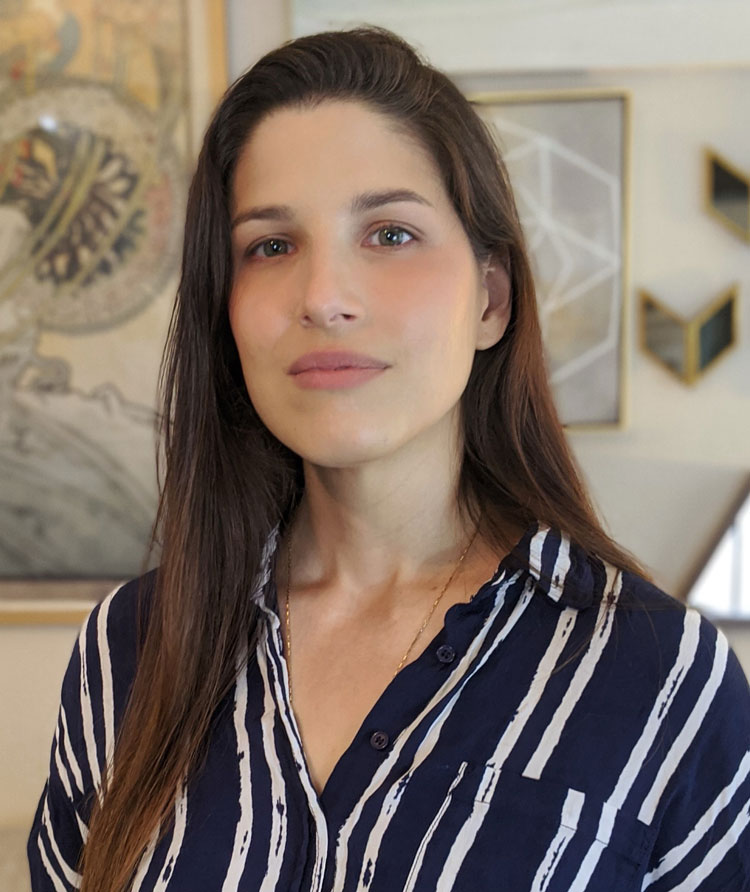Onyx Equinox begins when the Aztec god of the underworld, Mictlantecuhtli, levels a Zapotec city after stealing blood sacrifices from the other gods. This prompts god Quetzalcoatl to close the gates to the underworld. However, he can’t due do this due to said gates being made of obsidian, which is toxic against the gods. So instead he makes a bet with Tezcatlipoca: he will find a human, “the lowest of the low”, and crown one his champion so they will close the gates before the equinox, when Tezcatlipoca will kill off humanity.
The chosen is young Izel, who is forced to discard his apathy toward his fellow man and prove humanity’s potential. Soon Izel’s epic journey will take him across ancient Mesoamerica to save humanity from a war between the gods…
Onyx Equinox’s creator Sofia Alexander tells us about crafting the show’s characters and worlds, and why the show may not appeal to people who don’t like blood…
When did you first get the idea for Onyx Equinox?
The story began as a college assignment. Back then it was just a couple of comic strips featuring Izel, Nelli and Yaotl. From then, I continued using these characters and building their world in other assignments, and by the time I was working on my senior project I had a full story with various other characters.
If any, what were your inspirations when creating Onyx Equinox?
There were many inspirations behind the idea. I was born in Quintana Roo, Mexico, a state nearby many Maya archeological sites. My grandfather was proud of our indigenous heritage, and it was important to him we learned and were exposed to it as much as possible. My childhood memories are heavily tied with visiting the sites.
It was an obvious choice to tell a story set in such a beautiful era. When I learned how much history had been lost during Spanish colonisation, I found myself wondering what that world looked like, what parts of these huge civilizations were completely wiped away?
I loved Lord Of The Rings, which of course, is inspired by a mix of European mythologies. I started to imagine a Mexico that was just as magical and epic as that. Onyx Equinox is also heavily inspired by my own experiences growing up and figuring out my own perception of the world and society in general.

Was it daunting making your own show, and what was the biggest challenge?
Yes. It was a challenge as a first-time showrunner but I had Kuni Tomita, who is my supervising director as well as my mentor, and a wonderful supporting crew. Developing and writing the story wasn’t unlike any other show. My focus is on the characters and their development. Their emotions and trials and choices that would shape them and have a big impact on who they become.
I’d say the biggest challenge was to overcome my own doubts and trust my gut. To let go of certain things because of time constraints or other things outside of our control – that was a big one. There will always be room for improvement and no matter what you do, you’ll never please everyone. It was difficult, and it’s still something I practice every day. That said, knowing my team and I did our best, is enough to make me proud of what we’ve created.
What were your thoughts behind the show’s characters and how did you find their ‘voice’?
I knew I wanted an action/adventure, fantasy story of the hero’s journey, but back then I didn’t expect it to take a darker turn. I went through some dark times during my time creating Onyx. This influenced my work heavily and I found it cathartic to be able to express my feelings through these characters. Once I knew who Izel was and his purpose, the other characters just fell into place.
Izel isn’t a warrior, rather, he’s a young boy who was forced and baited during a very vulnerable and impressionable moment in his life to take on a near-impossible challenge. Izel’s story will be turbulent and will explore the uglier parts of him. His growth and healing won’t be linear, and his grief and apathy will be his companion throughout the series and determine the kind of relationships he shapes.
I knew he needed support in order to grow stronger and take on the heavy burden in his heart. Every single character in Onyx is that part of him which he lost, or a part of him he needs in order to succeed.
How did you go about building the world for the show?
I didn’t want to take on a specific story of myth, for sure. Though there are many beautiful mesoamerican stories begging to be told, I wanted to create a fantasy world where I can decide what the limits are, the message told and who our protagonists were.
I wanted to build a world that felt vast and full of lore to explore beyond the first season. My thoughts for inspiration kept going back to videogames more than TV shows or movies. I’m not an avid gamer but I do enjoy playing RPG games in which you can explore the world, choose what challenges to take next so the story feels less linear, defeat monsters and maybe figure out some temple puzzles.
We don’t go into detail about how the Olmec technology was created, where the monsters come from or when they began to roam the earth. Some details are better left unexplored in order to build a wider world. Much like how Lord Of The Rings expects us to believe that immortal elves and talking trees are just a normal thing not to be questioned in this world.
Of course, I would love to have multiple seasons in order to fully go into details of the world of Onyx Equinox, though! There’s so much we couldn’t fit in one season.
What were your thoughts and inspirations behind the look of Onyx Equinox?
My initial thoughts were that the visual aspect of the show had to represent Mexico. If there’s one big cultural trait of Mexico it is multi-colored. Colour has always had deep symbolism in our history. It was necessary to honor it. Red and turquoise were important colours in Mesoamerican Mexico; therefore they were a direct inspiration for the show. The bright pink we see in some of the stones is called ‘Mexican Pink’, which is considered an element of national identity and Mexican charisma. This, I thought, represents modern Mexico.
The design is a direct inspiration from anime. Mexico has broadcast anime since my mum was a child, and myself and many other Mexicans grew up familiar with these cartoons. Back then, I didn’t even know the term for Japanese-produced cartoons was anime! It was only natural for me to draw in a style I liked most, from stories I found more interesting, and whose characters I related to.

Did you do much research into myths and ancient beliefs before creating the show?
Yes. A big part of developing this show was copious amounts of research and sharing information. I don’t think I stopped researching until after production wrapped. There were always some little details to revise or look out for!
I was familiar with Mesoamerica, the stories, myths, and beliefs thanks to my education in Mexico. The same couldn’t be said for my team! It was important to introduce them to these concepts, so we had Dr. Kirby Farrah (an anthropologist and archaeologist), consult during the making of Onyx Equinox.
We [also] turned to the INAH (National Institute of Anthropology and History) website to help us find more information from the different cultures beyond what a general internet search could teach us – like blueprints of the cities we would be visiting and rebuilding.
The challenge was to make sure we didn’t search for things lightly. For the general public, it’s all too easy to accidentally confuse, for example, Totonac with a post-classic Maya artifact, and classify them within the same culture or periods. We had to be extra careful to cross-reference and look out for erroneous information.
Who would you recommend Onyx Equinox to?
Adults, for one! I’d recommend this story to anyone who’s curious about mesoamerican Mexico, like more adult-themed stories and get a kick out of fantastical elements. I think it goes without saying that this is also for people who aren’t bothered by blood or violence.
I’d hope that people who aren’t anime fans or into cartoons, could give this a chance.
What themes and ideas would you say audiences will take away from Onyx Equinox?
Well, the number one thing I get asked about most is the cultural, historical, and mythological elements, since this setting is unfamiliar to many people. I do hope that the audience becomes interested in learning more about the historical culture and myth, and that this story will create more interest in and open doors for other Latin American and Indigenous stories.
However, I hope that the core of the story is universal enough to be understood by anyone: When you’ve hit rock bottom, there’s always a way through.
What’s next for you?
I’m currently still working in the animation industry. I took a small break after the end of production but I took that time to revise the working outline for a second season. I hope I’m given the opportunity to continue telling Izel’s story. I am also working on finalising a pitch for another show I’m co-creating with my wife, as well as reviving a more kid-friendly cartoon I’ve had for a bit.
I don’t think I like sitting still!
Onyx Equinix is currently showing on Crunchyroll. Read our review of episode one here.
